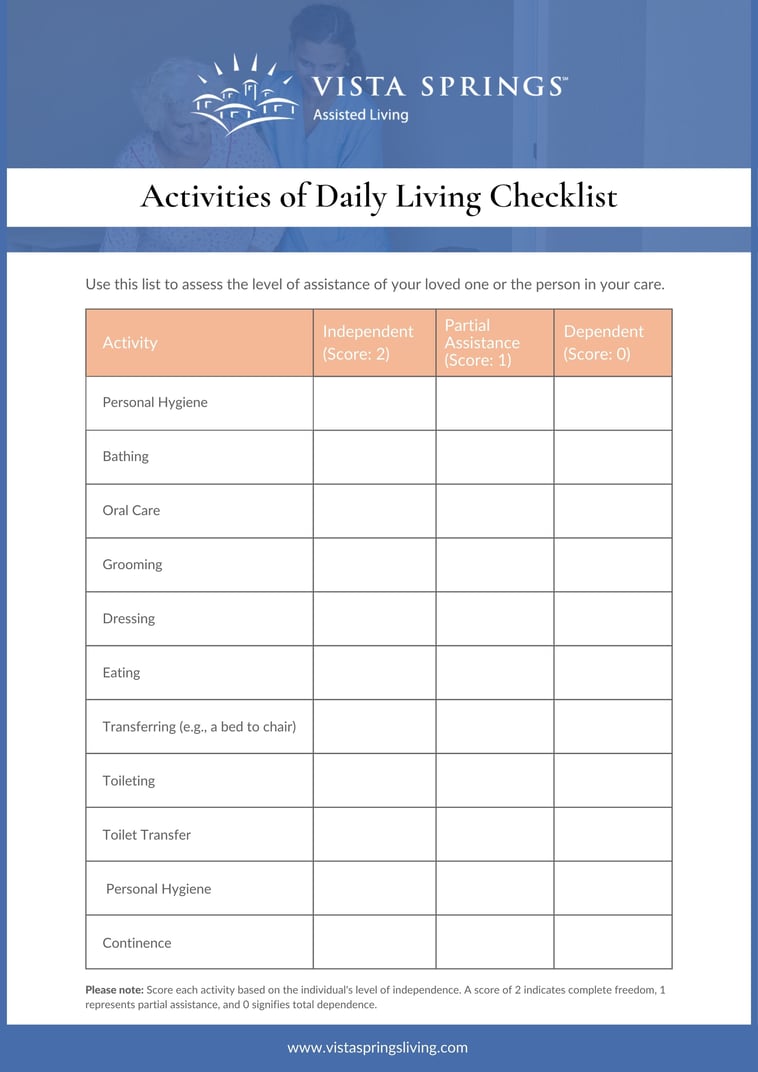As we age, we may face difficulties with basic activities of daily living (ADLs), due to physical decline, chronic illness, or cognitive impairment. It is essential to approach these challenges with empathy and an understanding of the impact on independence and well-being.
Healthcare professionals commonly use an ADL checklist to assess individuals’ capabilities in performing daily tasks independently. This tool provides a list of ADLs with assigned scores reflecting proficiency. It allows doctors, nurses, and caregivers to gain insights and offer appropriate support and care, considering an individual’s unique needs and challenges in their daily life.
Please take the next step towards enhancing well-being and independence by exploring our guide today.
Why is it Important to Use an ADL Checklist?
As a caregiver responsible for the well-being of seniors, an ADL checklist can be a valuable tool for you. You can utilize the checklist to support your caregiving efforts in multiple ways.
First, the checklist allows you to identify areas that require improvement by pinpointing them and guiding you in addressing them effectively.
Additionally, checklists are invaluable for monitoring progress over time. This resource becomes essential if you're actively enhancing your loved one’s health or well-being by promoting better nutrition or increasing exercise frequency.
How Can Healthcare Professionals Use It?
Healthcare professionals can use an ADL checklist to assess a person's ability to perform activities of daily living (ADLs). These activities are essential for independent living, such as bathing, dressing, eating, toileting, transferring, and walking. This resource identifies areas where the person may need assistance and develops a care plan to help seniors maintain their independence.
Here are some specific ways healthcare professionals can use ADL checklists:
- Assess a person's functional status: This information helps healthcare professionals make decisions about people’s health, such as whether they need to be admitted to a skilled nursing facility.
- Identify areas where a person may need assistance: This report provides information about their current needs to help the person maintain their independence.
- Develop a plan of care: This document helps to create a plan of care that allows people to maintain their independence with the right support.
- Monitor a person's progress: This statement determines if the plan of care is effective, allowing any necessary changes.
Example of ADLs
There are many different versions of an ADL checklist, but they all include tasks such as:
- Bathing: The individual cleanses their body in a bathtub or shower. It may involve getting in and out of the tub or shower, washing their body, and drying off.
- Dressing: This includes when the person wears appropriate clothing, such as a shirt, pants, and shoes. It concerns selecting an outfit, putting it on, and tying shoes.
- Toileting: This includes when people use the toilet to relieve themselves. It involves going to the bathroom, wiping themselves, and disposing of waste.
- Transferring: The individual moves from one place to another, such as from bed to a chair or from a chair to toilet. It may implicate using a wheelchair, walker, or other assistive device.
- Walking: The senior moves about their environment, such as walking to the kitchen or to the bathroom. It may involve using a cane, walker, or other assistive device.
- Eating: The person prepares and consumes food. It involves setting the table, cooking food, and eating.
- Grooming: The individual maintains their appearance, such as brushing their teeth, combing their hair, and shaving. It involves using a mirror, toothbrush, comb, or razor.
What information is included in an ADL checklist?
As we previously mentioned, an ADL checklist is a resource that assesses a person's ability to perform daily life activities. To create this document make sure that it includes a list of specific needs of the individual being assessed. However, some general information that should be included:
- The person's name and date of birth
- The person's ability to perform each ADL independently, with help, or not at all
- The type of assistance that the person needs with each ADL, if any
- The person's ability to perform each ADL safely
- The person's level of independence in performing each ADL
Activities of Daily Living Checklist
You probably know by now that a checklist is vital in evaluating the functional status and determining the level of assistance required for individuals with physical limitations, chronic illnesses, or cognitive impairments. By examining the person's performance in various ADLs, healthcare professionals can tailor their care plans and support services to enhance independence and quality of life.
Click here to download an ADLs Checklist template.

Please note: Score each activity based on the individual's level of independence. A score of 2 indicates complete freedom, 1 represents partial assistance, and 0 signifies total dependence. This checklist aims to comprehensively assess the individual's functional abilities and determine the appropriate support needed in their daily lives.
Vista Springs Assisted Living: A Personalized Approach to Senior Care
At Vista Springs, we fully believe everyone deserves to live a happy, fulfilling life, regardless of age or abilities. That's why we offer personalized assisted living services tailored to each resident's individual needs.
Our team of experienced professionals is dedicated to providing our residents with the highest quality of care, so they can focus on enjoying their retirement years.
Contact us today to learn more!





